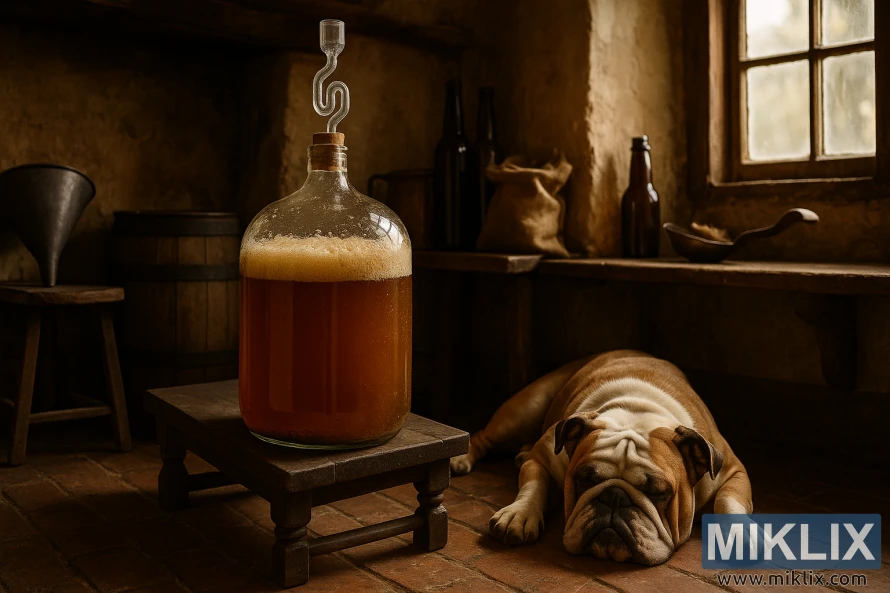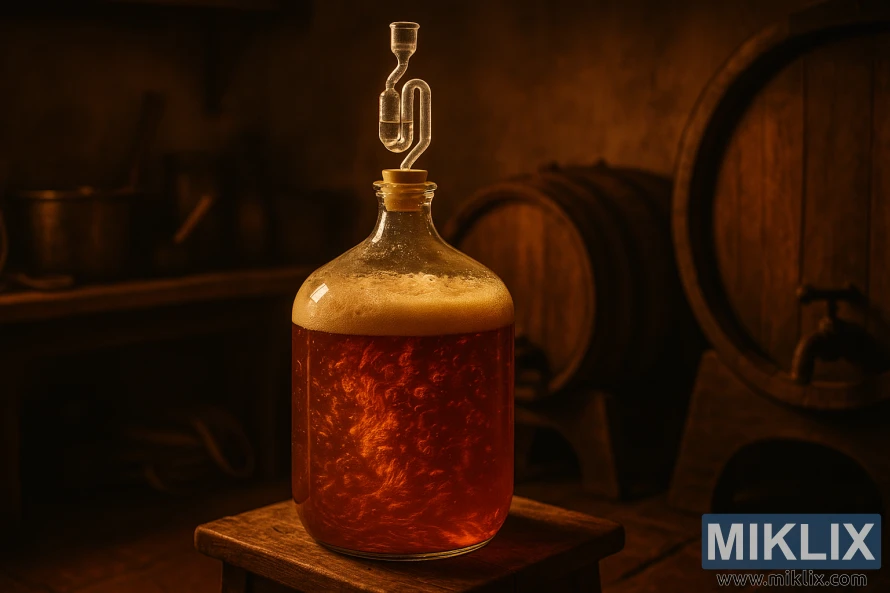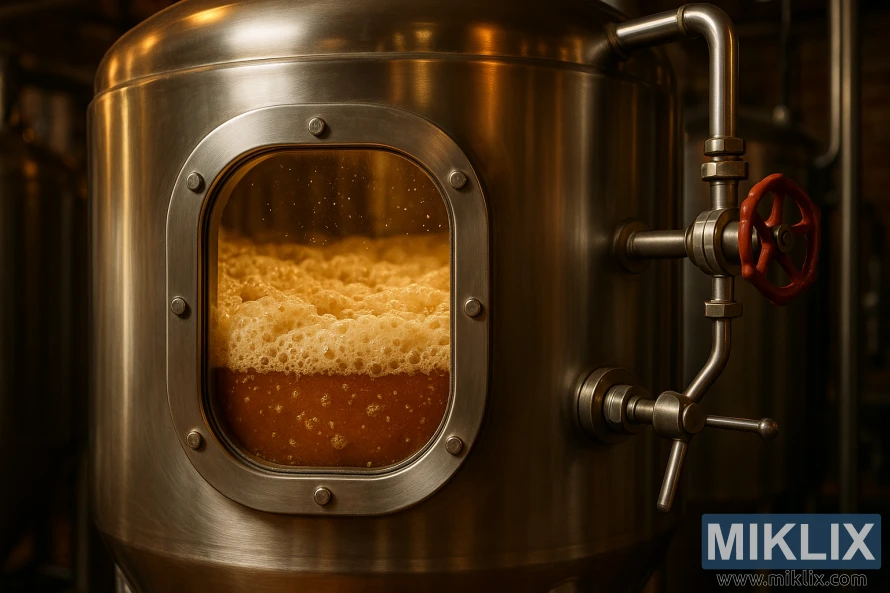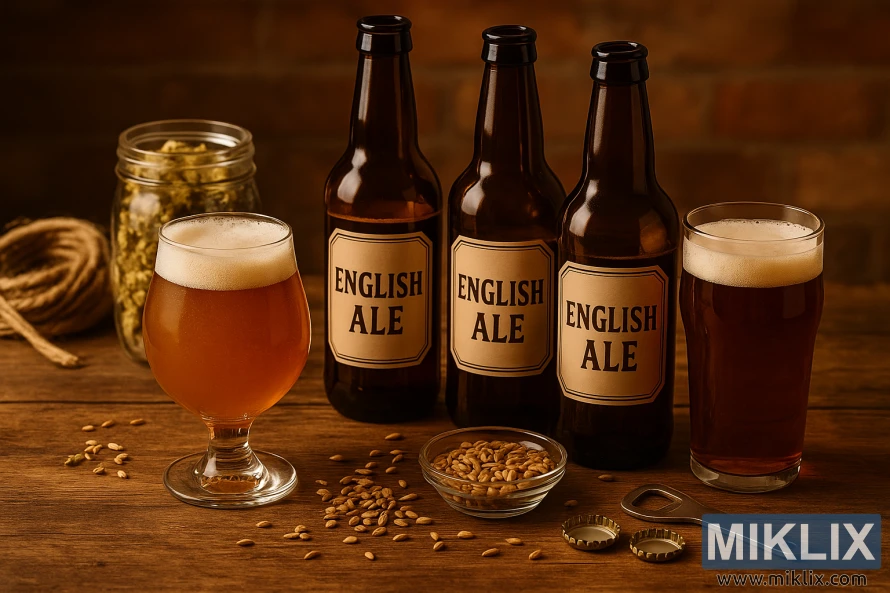Fermenting Beer with Bulldog B4 English Ale Yeast
Published: October 25, 2025 at 4:19:24 PM UTC
Bulldog B4 is a dry ale yeast, perfect for traditional British styles. It offers high flocculation, medium alcohol tolerance, and reported attenuation of 65–70%. This yeast is ideal for bitters, porters, milds, and brown ales, as it forms balanced esters without excessive fruitiness.

Packaging is available in 10 g sachets and 500 g vacuum bricks. The dosage is one 10 g sachet per 20–25 L (5.3–6.6 US gallons). Fermenting temperatures should be between 16–21°C (61–70°F), with 18°C (64°F) being the sweet spot for a classic English ale profile.
Feedback from the brewing community places Bulldog B4 alongside Safale S-04 for its fast fermentation and excellent clearing. Pitching is simple: just sprinkle the dry ale yeast B4 on top of the wort. Store the packs cool and wait for the yeast to settle, resulting in a clear beer once conditioning is complete.
Key Takeaways
- Fermenting Beer with Bulldog B4 English Ale yields classic English ester character with controlled fruitiness.
- Bulldog B4 review points to high flocculation and 65–70% attenuation for clean finishing.
- Dosage: 10 g sachet per 20–25 L; ferment 16–21°C, ideal around 18°C.
- Best for bitters, porters, milds, and brown ales where traditional profile is desired.
- Simple pitching—sprinkle on wort—and expect quick activity and good clearing.
Overview of Bulldog B4 English Ale Yeast and its profile
Bulldog B4 is a dry ale yeast designed for British-style beers. It has a dry English ale strain profile with an attenuation near the mid-60s. It also exhibits strong settling behavior. Brewers opt for it to achieve a true English character without the presence of heavy fruity esters.
The yeast's attenuation ranges from about 65–70%, leading to a balanced final gravity in many pale ales and bitters. It shows medium alcohol tolerance, making it suitable for session to moderate-strength ales when pitched and managed correctly.
B4 flocculation is high, facilitating quick beer clearing in fermenters and bottles. Community experiences align with product data: fermentations finish clean, sediment compacts firmly, and bottle conditioning is reliable with controlled priming.
Optimal fermentation occurs between 16–21°C, with many brewers aiming for 18°C. This temperature helps build a modest ester profile that complements English malts. The recommended dosage is a standard sachet of roughly 10 g per 20–25 L for typical homebrew batches.
- Fermentation range: 16–21°C, target 18°C for balance.
- Dosage: 10 g sachet per 20–25 L for single-pitch homebrews.
- Profile notes: reliable attenuation, high flocculation, moderate ester output.
Comparisons with popular strains like Safale S-04 show similar performance. Both exhibit predictable attenuation, steady fermentation, and a classic English ale flavor. This similarity makes Bulldog B4 an easy swap for brewers seeking a dependable dry option.
Why choose Bulldog B4 for traditional English ales
Bulldog B4 is designed for traditional British ales yeast. It's favored for porters because it produces complex yet subtle esters. These esters enhance the flavors of roast and biscuit malts.
The yeast's mid-attenuation, around 67%, ensures a full-bodied mouthfeel. This balance is crucial for bitters, allowing them to retain malt sweetness without becoming cloying.
Its high flocculation rate aids in quick beer clarity, aligning with the classic English style. With certifications for Kosher and EAC, it's accessible to both professional and home brewers.
Users often compare Bulldog B4 to S-04. Both strains offer balanced fruity and floral notes at warmer temperatures and clear quickly. This makes them ideal for authentic milds, brown ales, and porters.
- Consistent ester profile that complements caramel and toasted malts
- Good flocculation for clearer cask and bottle-conditioned beers
- Mid attenuation to preserve body in traditional recipes
Opt for Bulldog B4 bitters when aiming for a malt-forward character with a touch of fruity complexity. The English ale yeast benefits are most pronounced in recipes where malt and roast are key to the beer's identity.
Fermenting Beer with Bulldog B4 English Ale
Begin by cooling your wort to 16–21°C. This range is ideal for developing complex esters without overdoing fruitiness. Many brewers target 18°C as a middle ground for optimal fermentation with Bulldog B4.
Adhere to the recommended dosage: 10 g of dry yeast per 20–25 L for standard homebrew sizes. For bigger batches, a 500 g brick is suggested to ensure enough yeast cells. Keep sachets and bricks in a cool, dry place to maintain viability.
Follow straightforward steps for fermentation with Bulldog B4. If you prefer, sprinkle the dry yeast directly on the wort. Expect a 12–48 hour lag phase, typical for English dry strains. Fermentation should then proceed smoothly and clear well.
Keep an eye on gravity and temperature during primary fermentation. For more ester flavor, slightly increase the temperature towards the upper end of the range. Remember, an attenuation of about 67% will result in a fuller beer body.
- Pitching style: direct sprinkle or rehydrate if you prefer cautious handling.
- Target temp: 16–21°C, ideal single point ~18°C.
- Dosage: 10 g per 20–25 L; scale up for larger batches.
Document the fermentation process by noting the start time, peak activity, and gravity drops. This record is invaluable for replicating recipes or troubleshooting fermentation problems. The fermentation behavior mirrors that of S-04-like English yeasts, ensuring consistent results for English ale yeast fermentation.
Complete primary fermentation and allow for clearing before packaging. Proper yeast pitching and consistent temperatures are key to achieving the desired attenuation and flavor when fermenting with Bulldog B4.

Best beer styles and recipe ideas using Bulldog B4
Bulldog B4 is perfect for traditional British beer styles. It's ideal for bitters, porters, milds, and brown ales. This yeast preserves malt character and adds gentle British esters. It's used in over 210 recipes, showing its popularity in classic ales.
For bitters, Bulldog B4 is a reliable choice. Use 10 g per 20–25 L and ferment at 16–21°C. This temperature range keeps esters in check, allowing hop bitterness and malt to balance out in 5 to 6.6 US gallon batches.
Porters benefit from B4's high flocculation and mid attenuation. These traits help maintain body while clearing well. This is crucial for roast and chocolate malts, preventing harsh dryness. A malt bill with Maris Otter, crystal, and black patent is recommended for structure.
Brown ale recipes should focus on nutty and caramel malts. B4 helps maintain a soft mouthfeel and modest ester profile. A typical recipe might include 70–80% pale malt, 10–15% crystal 60–80L, and 5–10% brown or chocolate malt for color and depth.
- Simple Bitter: Maris Otter base, East Kent Goldings, moderate crystal, B4 pitched at 18°C.
- English Porter: Pale ale malt, brown malt, roasted barley, English Fuggles hops, B4 at 17–19°C.
- Brown Ale: Pale base, crystal 80L, medium roast, English hops, B4 at 16–20°C for balanced esters.
Feedback from the brewing community highlights B4's forgiving and predictable nature. Brewers achieve consistent results, making it a reliable choice for both extract and all-grain brews. Adjust mash temperature and grain bill to fine-tune body and final attenuation.
When adapting commercial recipes, remember the yeast dose and temperature guidance. For darker, malt-forward beers like porters and brown ales, aim for slightly warmer ferment temps. This supports desirable ester notes without overpowering the malt.
Comparing Bulldog B4 to other English and American dry yeasts
Brewers looking at Bulldog B4 and classic English yeasts must consider attenuation, flocculation, and ester profiles. Bulldog B4 has a medium alcohol tolerance, high flocculation, and about 67% attenuation. This positions it alongside many English dry strains, which favor malt presence and soft esters over a crisp, dry finish.
When comparing Bulldog B4 vs S-04, similarities in clearing speed and balanced ester expression emerge. S-04 is known for its fast fermentation and reliable flocculation, mirroring many reports on Bulldog B4. Both offer a fuller mouthfeel than American strains.
Examining B4 vs Nottingham vs US-05 reveals distinct differences. Nottingham tends towards neutrality with slightly higher attenuation in some batches, reducing body more than B4. US-05, an American ale yeast, ferments cleaner and drier, with near 80% attenuation and medium flocculation. This cleaner profile enhances hop character.
In yeast comparison English dry strains, B4, S-04, Windsor, and similar lines are often grouped together. These yeasts highlight malt complexity and restrained fruity esters. In contrast, West Coast strains like White Labs WLP001 or Wyeast 1056 and dry American strains like US-05 tend to be cleaner, showcasing hop aroma.
Practical considerations are key when choosing yeast. Bulldog B4's high flocculation leads to faster clearing and a fuller body, ideal for bitters, milds, and brown ales. For drier, crisper finishes in IPAs or pale ales, US-05 or Nottingham might be preferred. Pitching rate and temperature still influence the final aroma and attenuation, regardless of strain.
- Performance: Bulldog B4 vs S-04 — similar speed and clearing.
- Neutrality: B4 vs Nottingham vs US-05 — Nottingham is more neutral; US-05 is cleaner and drier.
- Style fit: yeast comparison English dry strains — choose B4 for malt-forward beers, US-05 for hop-forward beers.
Managing fermentation temperature for desired ester profile
Controlling the Bulldog B4 temperature is crucial for shaping the yeast ester profile. Aim for a ferment temp of 16-21C. This range allows for the production of complex, pleasant esters without entering harsh fruitiness territory.
Start with an initial target near 18°C for consistent performance and predictable ester control. This temperature promotes balanced banana and stone-fruit notes. It also ensures clean attenuation by the yeast.
Increasing the temperature by a few degrees towards the end of fermentation can soften residual sugars. This also nudges ester expression upwards. Yet, avoid temperatures above 21°C to prevent solvent-like off-flavors or unwanted tartness.
- Pitch at a stable wort temperature to shorten lag time and improve consistency.
- Use ambient control or a fermentation chamber for precise Bulldog B4 temperature management.
- Monitor gravity and aroma rather than relying solely on time when adjusting temps.
A ferment temp of 16-21C at the lower end yields a leaner, malt-forward profile. On the higher end, it delivers fuller fruit character from the yeast ester profile. This is beneficial in sweeter or more expressive English styles.
For effective ester control B4, record starting temperatures, ambient shifts, and sensory notes for each batch. This data helps refine the sweet spot for a specific recipe and environment, whether in a taproom or homebrewing setup.

Pitching and starter considerations for best results
The standard pitching rate for ales with Bulldog B4 is one 10 g sachet per 20–25 L (5.3–6.6 US gallons). This method is effective for most batches, provided wort oxygenation and temperature control are optimal.
For beers with higher original gravity or when using a 500 g vacuum brick, a B4 starter or rehydrating dry yeast is advisable. This approach increases viable cell count without the need for complex equipment. Following Lallemand's rehydration instructions can also reduce lag and enhance fermentation quality in challenging conditions.
Many homebrewers find sprinkle pitching convenient and effective. Yet, increasing the pitching rate can prevent prolonged lag times in larger beers. When repitching from bulk bricks, it's crucial to verify viability and consider a short starter to mitigate stress on the yeast culture.
Deciding between sprinkle pitch, rehydrating dry yeast, or a B4 starter is straightforward:
- For 20–25 L everyday ales: follow the Bulldog B4 pitching rate and sprinkle on top of cooled wort.
- For high-gravity or lag-prone ferments: rehydrate dry yeast or build a B4 starter to raise cell count.
- For large-scale batches from vacuum bricks: measure viable yeast and scale starters proportionally.
Ensure yeast storage remains cool and handle sachets with care. Adequate oxygenation, correct wort temperature, and clean equipment are essential. These factors complement any pitching method, from sprinkle pitch to rehydration or B4 starter, for a healthy fermentation.
Signs of healthy fermentation and troubleshooting
When fermenting with Bulldog B4, look for a steady krausen and visible CO2 activity within 12–48 hours. Typical signs include a frothy head, rising bubbles in an airlock, and an active yeast ring on the vessel wall.
Expect reliable attenuation near 67% when kept in the 16–21°C range. A clean, consistent drop in specific gravity over several days shows the yeast is completing its job. Short lag times of 12–24 hours are common; moderate lags up to 48 hours can occur with cooler wort or underpitching.
If fermentation is sluggish, use troubleshooting B4 yeast steps. Gently raise temperature toward the upper end of the 16–21°C window to revive activity. Verify original gravity and measure current gravity with a hydrometer to confirm true progress.
Address underpitching by checking your pitching method. Sprinkle pitching at an 18°C pitch temperature minimizes lag. Rehydration or preparing a small starter reduces risk of slow starts for high-gravity worts.
- Ensure adequate oxygen at pitch for healthy yeast growth.
- Add yeast nutrient if the wort is stressed or contains adjuncts.
- Keep sanitization high to avoid contamination masking yeast activity.
For suspected stuck fermentation, use tested stuck fermentation solutions. Raise the fermenter temperature a few degrees, gently swirl to resuspend yeast, and re-check gravity after 24–48 hours. If gravity remains unchanged, pitch a small amount of a robust, neutral strain such as SafAle US-05 or Wyeast 1056 to restart fermentation.
Document timings, temperatures, and gravities for each batch. Good records help isolate patterns and improve future troubleshooting B4 yeast decisions. Consistent monitoring leads to cleaner, more predictable Bulldog B4 fermentation signs and faster recovery when interventions are needed.
Conditioning, flocculation, and clearing expectations
Bulldog B4 flocculation is high, leading to rapid sedimentation and a dense yeast bed. This characteristic is beneficial for achieving a clear appearance in English ales. It simplifies transfers and racking, enhancing the packaged beer's quality.
Proper conditioning of Bulldog yeast is crucial for clarity. Cold conditioning for a few days to two weeks allows krausen to drop and proteins to settle. Bottle or keg conditioning on standard English ale timelines generally results in predictable clarity.
Timing dry hopping before heavy flocculation is essential. Some strains pull hop compounds out of suspension as they flocculate. This ensures the hop aroma is maintained while benefiting from Bulldog B4 flocculation.
- Allow primary fermentation to finish fully before cold crashing.
- Give at least 3–10 days of cold conditioning, longer for larger beers.
- Use gentle transfers to avoid disturbing the compact sediment.
Community reports highlight B4's comparison to Wyeast S-04 in clearing speed and sediment behavior. Brewers appreciate clear bottles and reliable settling, which is crucial for styles where clarity and presentation are key. Expect both fast settling and a neat yeast cake for easier packaging.
When monitoring beer clearing B4, focus on gravity and visual clarity rather than a fixed calendar. Conditioning Bulldog yeast requires patience. A few extra days in cold storage often results in a brighter beer and reduces chill haze risk.

Effect on hop expression and interplay with malt
Bulldog B4 is known for its restrained ester production, allowing malt flavors to take center stage. Its attenuation near 67% results in a slightly fuller body. This supports traditional English malts, preventing bitterness from overpowering the taste.
High flocculation in Bulldog B4 aids in faster beer clarity by efficiently removing yeast from suspension. This clarity can subtly reduce the perceived intensity of hop aroma. Thus, timing dry-hop additions becomes crucial for achieving the desired malt-hop balance.
For brewers aiming for a pronounced hop nose, the yeast's impact on aroma is critical. Strains like US-05 or Wyeast BRY-97 tend to enhance hop esters. In contrast, Bulldog B4's hop expression is more subdued compared to these neutral American strains.
- Use later dry-hopping to preserve aroma when working with Bulldog B4.
- Consider whirlpool hop additions to boost volatile oils without increasing bitterness.
- Adjust wort gravity slightly if you need a different malt-hop balance B4 delivers naturally.
Bulldog B4 is ideal for malt-forward English ales, enhancing biscuit and toffee notes while keeping hop character in check. The yeast's impact on aroma is key in determining how long hop volatiles remain noticeable during conditioning.
In comparative brews, expect a modest hop lift from Bulldog B4 compared to stronger accentuation from American ale strains. If you prefer a hop-forward profile, consider adjusting the hopping schedule or choosing a strain that emphasizes hop esters more than Bulldog B4.
Recipe scaling, dosage, and packaging options
For home brewers, using Bulldog B4 is simple: one 10g sachet is enough for a 20–25 L (5.3–6.6 US gallons) batch. This dosage is ideal for most English ale recipes. It also ensures a short lag time, even with moderate gravity.
Scaling up B4 recipes requires careful planning of the pitch rate. For bigger batches or higher gravities, increase the pitch rate or use multiple sachets. Commercial brewers often opt for 500g vacuum bricks. These are used to create a larger starter or to rehydrate several pitches from one package.
Packaging options include single 10g sachets (item code 32104) and 500g vacuum bricks (item code 32504). Both formats are certified Kosher and EAC. Brewers prefer sachets for one-off batches and bricks for repeated use or bulk production.
- Standard single-batch use: sprinkle or rehydrate one 10g sachet per 20–25 L.
- Larger batches: use multiple 10g sachets or a portion of a 500g brick to build a starter.
- High-gravity or stressed worts: consider rehydration to reduce lag.
Yeast storage is crucial for maintaining viability. Keep the product cool and use it before the best-by date. Cold storage helps preserve cell health, ensuring the Bulldog B4 dosage remains effective when pitching.
Community practices vary. Many brewers stick to the sprinkle-on method for routine batches. For consistent results in larger or richer beers, plan the starter volume from a 500g brick or boost the pitch rate with extra 10g sachets.
Real-world reviews and community feedback
Product listings reveal 210 recipes utilizing Bulldog B4, indicating its widespread adoption. This volume underscores its popularity among homebrewers and craft operators. It shows the yeast's versatility in brewing British styles.
The manufacturer's specs and packaging make Bulldog B4 suitable for small batches. Clear packaging and precise dose options instill confidence in brewers. This is crucial for planning starters or direct pitching.
Forum discussions and tasting notes often compare Bulldog B4 to English strains like S-04 and Windsor. Community feedback highlights its consistent clearing and tight flocculation in clear bottles.
- Brewer experiences B4 report predictable attenuation when users follow recommended temperatures.
- Some posts compare its ester profile to S-04, noting slight differences in fruitiness across recipes.
- Many brewers praise how the yeast compacts to the bottom, easing racking and bottling.
Bulldog B4 reviews are generally positive for traditional ales and bitters. Users appreciate its reliability, ease of use, and clean fermentation under standard English ale regimes.
Community feedback B4 includes practical tips on dosing and temperature control, aligning with manufacturer guidance. Those who match pitch rate to gravity achieve the most consistent results.
Brewer experiences B4 vary by recipe and mash profile, yet most users find the yeast predictable. This predictability is invaluable for scaling recipes or switching between similar dry English strains.

Advanced techniques: blending, repitching, and hybrid fermentations
Bulldog B4 repitching is ideal for brewers aiming for consistent results. The 500 g vacuum bricks enable multiple generations, perfect for small breweries and dedicated homebrewers. It's crucial to store these bricks in a cool environment and verify their viability before creating a starter or scaling up the pitch.
Blending yeasts B4 allows brewers to fine-tune the final gravity and mouthfeel of their beers. For a drier finish, blend B4 with a yeast that attenuates more. To retain haze and esters, pair B4 with a yeast that flocculates less, enhancing fruit-forward flavors.
Hybrid fermentations with Bulldog are favored for East-meets-England pale ales. Combining B4 with a clean American strain like US-05 or BRY-97 balances ester production and hop clarity. The choice between pitching the cleaner strain first or co-pitching depends on the desired aroma and ester levels.
- Plan cell counts for Bulldog B4 repitching and adjust dosage against generations to avoid viability loss.
- Crop and propagate singles on sterile starters to reduce flavor drift when repitching.
- Test small pilot batches when experimenting with blending yeasts B4 to confirm attenuation and ester balance.
Community practices reveal that blending high- and low-attenuation yeasts can hit style targets without significant recipe adjustments. It's important to track flavor changes over successive repitches and retire lineages showing off-flavors. For hybrid fermentations, closely monitor fermentation kinetics to prevent stalled batches.
Short, controlled trials are essential to fine-tune blend ratios. Keep detailed records of pitch rates, temperatures, and final gravity for each blend. This disciplined approach ensures that Bulldog B4 repitching and blending yeasts B4 are both repeatable and predictable, benefiting both professional and hobby brewers.
Practical checklist for a Bulldog B4 fermentation batch
Prepare a reliable, repeatable fermentation with this Bulldog B4 brewing checklist. Set the room or chamber target to 18°C. Keep the range between 16–21°C to preserve the classic English ester balance.
Gather supplies before brew day. Have 10 g sachets for single batches or 500 g bricks if you plan to repitch. Store yeast refrigerated until use. Measure oxygenation tools, hydrometer, and a temperature controller.
- Dosage and handling: 10 g per 20–25 L is standard. Rehydrate for high-gravity or stressed worts. Sprinkle-on pitching works well for most home batches.
- Pitching: Pitch directly onto wort after proper oxygenation. Aim for active fermentation within 12–48 hours and watch krausen formation.
- Temperature control: Maintain the set range. If activity stalls, raise temperature a degree or two, staying inside the safe window.
- Monitoring: Use a hydrometer to check gravity progress. Track daily until fermentation nears terminal gravity.
- Conditioning: Allow adequate time for clearing and flocculation before packaging. Plan dry hop timing to avoid losing aroma if yeast shows high flocculation.
Keep a B4 fermentation checklist on the wall or brew log. Note pitch time, initial gravity, peak activity, and conditioning days. Record any temperature adjustments and oxygenation method.
- Troubleshooting quick tips: ensure proper oxygen at pitch to prevent sluggish starts.
- If stuck fermentation persists, consider a small additional yeast pitch or a yeast nutrient treatment.
- For packaging, choose bottles or kegs after clear gravity readings and stable samples for two to three days.
Follow these brew day B4 steps on every batch to reduce risk and improve consistency. A short, repeatable checklist keeps beers tasting true to traditional English styles like bitters, porters, and brown ales.
Conclusion
Fermenting Beer with Bulldog B4 English Ale conclusion: Bulldog B4 is a standout dry English ale yeast. It boasts about 67% attenuation, high flocculation, and a medium alcohol tolerance. Its ideal fermentation range of 16–21°C preserves malt character and limits esters. This makes it perfect for traditional British styles like bitters, milds, brown ales, and porters.
B4 final verdict: its practical specs are a boon for homebrewers and small-scale producers. It requires only 10 g per 20–25 L, and pitching is simple. Its kosher/EAC-certified packaging adds to its appeal. Feedback from the brewing community places it alongside trusted strains like Safale S-04. It clears quickly and produces classic English ale notes without overpowering malt depth.
Best uses Bulldog B4: it excels where malt-forward balance and clear conditioning are key. For brewers seeking straightforward performance, predictable attenuation, and ease of use, Bulldog B4 is a reliable choice. It works well with hybrid techniques or repitches when needed. Overall, it's a solid, accessible option for those aiming for traditional English ale character with minimal effort.
Further Reading
If you enjoyed this post, you may also like these suggestions:
- Fermenting Beer with Fermentis SafLager W-34/70 Yeast
- Fermenting Beer with Mangrove Jack's M15 Empire Ale Yeast
- Fermenting Beer with CellarScience Voss Yeast
